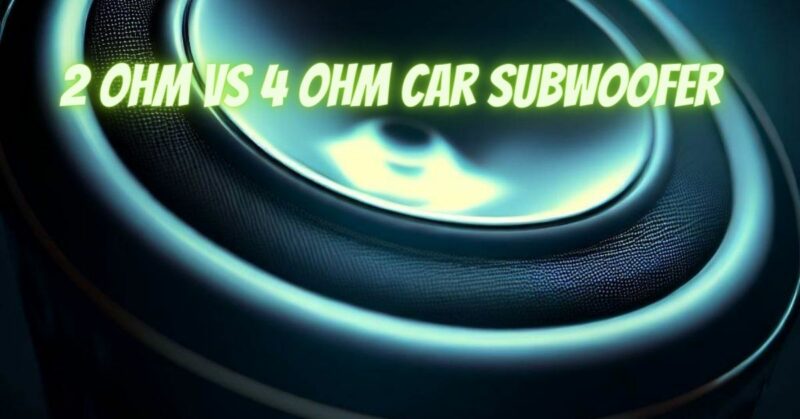When it comes to upgrading your car audio system with a new subwoofer, one of the key considerations you’ll face is the choice between different impedance ratings, specifically 2-ohm and 4-ohm car subwoofers. These impedance values can significantly impact how your subwoofer performs and integrates with your car audio setup. In this article, we’ll explore the differences between 2-ohm and 4-ohm car subwoofers, helping you make an informed decision for your car audio needs.
Understanding Subwoofer Impedance:
Before we dive into the comparison, let’s briefly understand what impedance means in the context of car subwoofers:
- Impedance (Ohms): Impedance is the electrical resistance a subwoofer presents to the amplifier. It’s measured in ohms (Ω). Subwoofers with lower impedance values (e.g., 2Ω) have less electrical resistance and can draw more power from the amplifier, potentially delivering higher volume levels. Subwoofers with higher impedance values (e.g., 4Ω) offer greater electrical resistance, which means they require less power to achieve the same volume levels.
Comparison between 2-Ohm and 4-Ohm Car Subwoofers:
Now, let’s explore the differences between these two common impedance ratings:
1. Power Handling:
- 2-Ohm Subwoofers: These subwoofers typically have higher power handling capabilities. They can handle more power from the amplifier, making them a suitable choice for those seeking powerful and impactful bass.
- 4-Ohm Subwoofers: While 4-ohm subwoofers may not handle as much power as their 2-ohm counterparts, they can still provide excellent performance. They often require less amplifier power to achieve desired volume levels.
2. Amplifier Compatibility:
- 2-Ohm Subwoofers: These subwoofers are well-suited for amplifiers designed to work with lower-impedance loads. If your amplifier is stable at 2 ohms, a 2-ohm subwoofer can provide maximum power output.
- 4-Ohm Subwoofers: These subwoofers are more versatile when it comes to amplifier compatibility. They can work with a broader range of amplifiers, including those that are not 2-ohm stable.
3. Wiring Options:
- 2-Ohm Subwoofers: When wiring multiple subwoofers, 2-ohm subwoofers can be wired in parallel to achieve a 1-ohm load, or in series to achieve a 4-ohm load.
- 4-Ohm Subwoofers: These subwoofers can be wired in parallel to achieve a 2-ohm load, or in series to achieve an 8-ohm load when using multiple subwoofers.
4. Heat Dissipation:
- 2-Ohm Subwoofers: Due to their higher power handling, 2-ohm subwoofers may generate more heat. Adequate ventilation and cooling are essential when using powerful 2-ohm subwoofers.
- 4-Ohm Subwoofers: These subwoofers typically generate less heat, which can be advantageous for extended listening sessions and amplifier longevity.
5. Sound Quality:
- 2-Ohm Subwoofers: When matched correctly with a compatible amplifier, 2-ohm subwoofers can deliver powerful and impactful bass. However, improper matching can lead to distortion and reduced sound quality.
- 4-Ohm Subwoofers: These subwoofers can provide good sound quality with a wide range of amplifiers. They are often preferred for maintaining cleaner bass in setups where power requirements are not extreme.
In conclusion, the choice between 2-ohm and 4-ohm car subwoofers depends on your specific car audio needs, amplifier compatibility, and desired bass performance. 2-ohm subwoofers are ideal for those seeking powerful bass with the right amplifier, while 4-ohm subwoofers offer versatility and can provide excellent sound quality. Carefully consider your amplifier’s specifications and your listening preferences when selecting the impedance rating that suits your car audio setup best.


